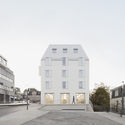查看完整案例


收藏

下载

翻译
Architects:VON M
Area :1377 m²
Year :2018
Photographs :Zooey Braun
Engineering :Ingenieurbüro für Bauwesen Seiler
Clients : Evangelische Kirchengemeinde Kehl
Design Team : Márcia Nunes, Timm Radt, Marcin Wasag
City : Kehl
Country : Germany
The oldest church in Kehl should be established as the central location of the parish by expanding the administration into a multi-functional parish center through the construction of a new parish hall and the refurbishment of the Christus-Kirche built in 1822 by Hans Voss, a Weinbrenner “disciple”. The spatial concept of the community center is similar to that of a cloister, the central element of which, however, is not an inner courtyard but the community event hall. This central, column-free community hall can be read from the outside due to its greater room height and a side skylight that serves for lighting and ventilation.
All around is the access and a band of adjoining rooms running along the closed façade, which is interrupted by two large windows that provide lighting for the meeting rooms and group rooms as well as the corridor zone. The event hall and the two adjacent group rooms can be interconnected in numerous combinations via folding walls. This ensures maximum flexibility in use. In the spirit of Weinbrenner's classicism, the architecture of the community center is determined by a consistent, clear geometric order, precise details, the use of light and pure and comprehensible use of materials.
The new building was bricked with mineral-insulated vertically perforated bricks. The structure of the monolithic brickwork remains visible as a technical ornament, as some of the stones were only partially slimed with lime, while others were scraped with filler. The interplay of the bricks, their final treatment and the changing light situations in the house thus results in a lively interplay of differently structured surfaces. The large span of the event hall is realized with a system of beams and ceiling elements made of plywood. The wooden surfaces were lightly glazed and adapted to the color of the washed walls.
In combination with the laterally arranged skylights, an attractive play of the construction and structure is created with the changing existence of light during the day. The restoration of the old substance of the church was aimed at reconstructing the original shape and chromaticity of the classicist church in order to restore the building to its original quality and identity. In combination with the modern interventions, a new site was created that combines tradition and future both in terms of design and use. The existing pews were abandoned in favor of flexible seating in order to do justice to a multi-functional church space for a wide range of uses.
Furthermore, all the principles were also designed as mobile "pieces of furniture" in order to guarantee maximum flexibility of the church space. The most important new element, however, is a wall which can be moved and opened along the longitudinal axis of the church, enabling different room layouts and proportions, as well as the separation of smaller areas of retreat, thus significantly supporting the varied use of the church. All fixtures were consistently kept in natural oak and thus create a subtle contrast to the existing building, which was returned to its light, monochrome coloring.
▼项目更多图片






























